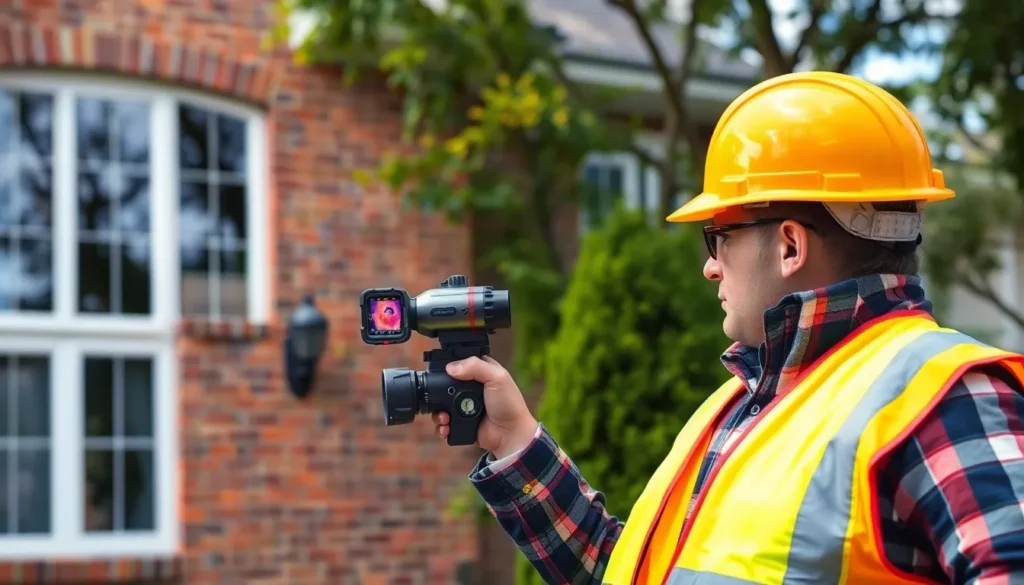In a world where spotting energy leaks is as crucial as finding your missing sock, building thermal imaging steps up to the plate like a superhero in a cape. Imagine being able to see heat signatures like a wizard with a magic wand—no more guessing where your energy dollars are disappearing! This technology offers a peek into the hidden world of your building’s thermal performance, revealing hot spots and chilly drafts that could be costing you a fortune.
But it’s not just about saving money; it’s about saving the planet too. With building thermal imaging, you can make informed decisions to enhance energy efficiency and reduce carbon footprints. So why not trade in those old-fashioned guesswork methods for a high-tech solution that’s as cool as it is hot? Dive into the world of thermal imaging and discover how it can transform your building into a cozy, energy-efficient haven.
Table of Contents
ToggleOverview of Building Thermal Imaging
Building thermal imaging utilizes advanced camera technology to assess and analyze heat variations in structures. This method provides insight into energy efficiency and can help identify potential issues.
What Is Building Thermal Imaging?
Building thermal imaging refers to the use of infrared cameras to detect heat patterns in buildings. These cameras capture thermal radiation emitted by objects, converting it into visible images. Users can see temperature differences that indicate energy inefficiencies like air leaks, insulation gaps, and moisture problems. This technology ensures property owners can pinpoint temperature anomalies that may not be visible to the naked eye.
Importance in Building Inspections
Building thermal imaging plays a critical role in inspections by providing a comprehensive view of a structure’s energy performance. Thermal images assist inspectors in identifying weaknesses in insulation and other energy loss areas. The technology allows for proactive maintenance, helping to avoid costly repairs or energy waste. By enhancing building inspections, thermal imaging significantly contributes to energy savings and improved comfort for occupants.
Applications of Building Thermal Imaging
Building thermal imaging offers various practical applications, enhancing energy efficiency and structural integrity.
Energy Audits
Energy audits benefit significantly from thermal imaging. By identifying heat loss areas, professionals determine where insulation lacks effectiveness. Observations reveal electrical inefficiencies, highlighting problems like overheating equipment or faulty circuits. Inspectors often use thermal cameras to assess the effectiveness of heating and cooling systems. When analyzing results, they can pinpoint energy waste sources, guiding necessary improvements. Ultimately, using thermal imaging facilitates comprehensive energy audits, resulting in reduced utility costs and enhanced comfort.
Moisture Detection
Moisture detection represents a crucial application of thermal imaging technology. When inspections reveal unexpected temperature differences, it often indicates moisture presence. Inspectors may locate hidden leaks or condensation problems, helping to prevent mold growth. Addressing these issues timely minimizes structural damage and health risks. Detecting anomalies through thermal images can also lead to identifying irrigation system inefficiencies. Therefore, employing thermal imaging aids in comprehensive moisture assessments, ensuring buildings remain safe and dry.
Pest Infestations
Pest infestations often go unnoticed until significant damage occurs. Thermal imaging provides a proactive approach to detecting these issues. The heat generated by pests, like termites or rodents, creates temperature differences that thermal cameras can visualize. Identifying these hotspots allows inspectors to target remediation efforts effectively. This method not only speeds up detection but also limits property damage by allowing for early intervention. Thus, using thermal imaging in pest management enhances overall property maintenance strategies.
Technology Behind Building Thermal Imaging
Building thermal imaging relies on sophisticated technology that allows professionals to assess energy efficiency. This technology integrates advanced infrared cameras and image processing techniques to provide accurate thermal assessments.
Infrared Cameras
Infrared cameras serve as the backbone of thermal imaging technology. These cameras detect infrared radiation emitted by objects, converting it into thermal images. Users visualize temperature differences, which helps identify areas of heat loss or energy inefficiencies. Many models include features like adjustable settings for different environments, increasing versatility. High-resolution options allow for detailed inspections of building envelopes, revealing insulation gaps and air leaks that aren’t visible to the naked eye. These cameras improve quick assessments, ensuring timely interventions in energy audits and inspections.
Image Processing Techniques
Image processing techniques enhance the clarity and usability of thermal images. Algorithms process raw data to filter out noise and emphasize critical temperature variations. Color palettes highlight different temperature ranges, making it easier to identify problem areas. Advanced image fusion methods combine thermal data with conventional images, providing context for the thermal findings. Multiple processing approaches result in clearer visuals, allowing users to pinpoint issues swiftly. By leveraging these techniques, building inspectors can create comprehensive reports detailing energy efficiency and identifying necessary repairs.
Benefits of Using Building Thermal Imaging
Building thermal imaging technology offers numerous advantages for energy efficiency and maintenance. Its ability to visualize heat signatures leads to significant benefits for property owners and inspectors alike.
Cost Savings
Cost savings materialize quickly with the implementation of thermal imaging. Many property owners notice reductions in their energy bills after identifying and addressing areas of heat loss or inefficiencies. Efficient insulation and proper sealing enhance comfort and lower heating and cooling demands. Moreover, early identification of issues prevents costly repairs in the future. Detecting moisture problems and electrical faults reduces long-term expenses, further optimizing budgets. As inspectors generate detailed reports, actionable recommendations can guide improvements and maximize savings over time.
Improved Energy Efficiency
Improved energy efficiency plays a crucial role in sustainable building practices. Thermal imaging allows for precise identification of energy losses, leading to informed decisions on upgrades. Inspectors easily locate insulation gaps, air leaks, and other inefficiencies, providing a comprehensive analysis of a structure’s performance. Enhancements in energy efficiency not only reduce operational costs but also contribute to a smaller carbon footprint. Implementing recommended changes boosts overall performance and fosters a commitment to environmental sustainability. Building owners create more comfortable living spaces while supporting global efforts to conserve energy and minimize waste.
Challenges and Limitations
Building thermal imaging faces several challenges and limitations that can affect its effectiveness. These issues often arise from environmental factors and the interpretation of data.
Environmental Factors
Weather conditions, such as rain or snow, can interfere with thermal imaging accuracy. High humidity levels might obscure thermal signatures, leading to misleading readings. Sun exposure poses another challenge, as heated surfaces can misrepresent temperature differences. Additionally, external temperatures impact the efficiency of thermal cameras. Cold weather can reduce battery performance and affect sensor calibration. Contaminants, like dirt or fog on the camera lens, can also distort images. Each of these factors highlights the need for optimal conditions during inspections to ensure reliable results.
Interpretation of Data
Interpreting thermal images requires expertise and training to avoid misdiagnosis. Variations in building materials can create confusion, as different surfaces might emit heat differently. Anomalies in data might arise from thermal bridging or insulation inconsistencies, complicating analysis. Moreover, the context of the building’s environment plays a significant role in interpreting findings accurately. Inspectors must understand how objects within a thermal image interact to make informed decisions. Misinterpretations may lead to unnecessary repairs or overlooked issues. Proper training and practice remain essential for professionals to navigate these complexities.
Conclusion
Building thermal imaging stands out as a powerful tool for enhancing energy efficiency and maintaining structural integrity. By identifying energy leaks and potential issues early on, it empowers property owners to make informed decisions that lead to significant cost savings and improved comfort. The advanced technology behind thermal imaging not only aids in energy audits but also plays a crucial role in moisture detection and pest management.
As the importance of sustainability grows, adopting building thermal imaging becomes essential for anyone looking to reduce their carbon footprint. Embracing this innovative solution not only promotes a more efficient living environment but also supports a broader commitment to environmental responsibility. Investing in thermal imaging technology is a step toward a more energy-conscious future.











